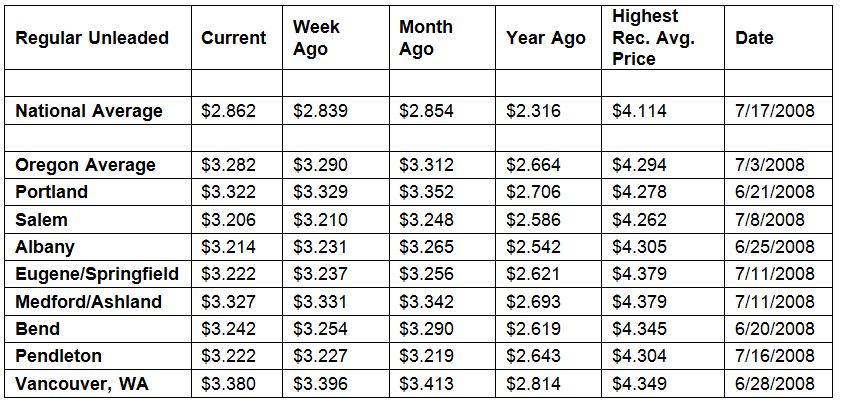PORTLAND, Ore., – Demand for gasoline in the U.S. is soaring toward new heights and inventories are tightening, putting upward pressure on gas prices, especially on the East Coast. The national and Oregon averages are holding fairly steady for the week. The national average remains at $2.86 while Oregon’s average ticks down half a cent to $3.28.
At 9.88 million b/d, gasoline demand last week was near an all-time record high according to the U.S. Energy Information Administration (EIA). More so, the latest EIA data shows gasoline inventories tightening from 240 million bbl at the end of June down to 231 million bbl at the end of July.
“We may see prices rally this month as inventories continue to tighten,” says Marie Dodds, public affairs director for AAA Oregon/Idaho. “This week’s EIA demand and inventory reports will give us a better idea of how much higher gas prices could jump as the summer winds down.”
Oregon is one of 21 states and the District of Columbia where prices are lower now than a week ago. The largest decreases are in Michigan (-8 cents) and Indiana (-6 cents). Other states are reporting smaller declines of three cents or less. The largest weekly increases are in Delaware (+6 cents) and Idaho (+6 cents). The averages in Arkansas, New York and Wyoming are flat. This week 12 states have averages at or above $3 a gallon, same as a week ago.
Oregon is one of 25 states where prices are lower than one month ago. The national average is the same price as a month ago and the Oregon average is four cents less than a month ago. Oregon has the 11th-largest monthly decrease in the country. Arizona (-10 cents) has the largest monthly decrease, while Delaware (+6 cents) has the largest monthly increase.
The West Coast continues to have the most expensive gas prices in the nation. Hawaii tops the list for the ninth week in a row with California, Washington, Alaska, Oregon and Nevada rounding out the top six. Oregon is fifth for the seventh consecutive week. Prices in all West Coast states are down slightly this week. Alaska has the largest decline of one cent.
| Rank | Region | Price on 8/7/18 | |
| 1 | Hawaii | $3.77 | |
| 2 | California | $3.62 | |
| 3 | Washington | $3.40 | |
| 4 | Alaska | $3.37 | |
| 5 | Oregon | $3.28 | |
| 6 | Nevada | $3.19 | |
| 7 | Idaho | $3.17 | |
| 8 | Utah | $3.09 | |
| 9 | Connecticut | $3.07 | |
| 10 | Pennsylvania | $3.07 |
According to EIA’s petroleum status report for the week ending on July 27, inventories of gasoline in the West Coast region dropped by 400,000 bbl. They now sit at 30.2 million bbl, which is nearly 3.5 million bbl lower than total levels at this time last year. Tighter supplies leave little cushion for price shocks, which could increase prices at the pump if supply becomes more constrained.
The nation’s cheapest markets are Mississippi ($2.57) and Alabama ($2.58) and. For the 53rd week in a row, no states have an average below $2.
Drivers in all 50 states and the District of Columbia are paying more than a year ago to fill up. The national average is 52 cents more and the Oregon average is 60 cents more than a year ago. This is the sixth-largest yearly increase in the country. Hawaii (+71 cents) has the greatest year-over-year increase; Arizona (+68 cents) is second; California (+66 cents) is third; Utah (+62 cents) is fourth; and Idaho (+60 cents) is fifth.
Oil Market Dynamics
Crude oil prices made some gains last week, but are ending at a loss after EIA reported that total oil inventories across the country grew by 5.6 million bbl last week. The build in crude stocks was supported by crude exports falling to 1.31 million b/d.
Crude price losses may not extend into this week as global supply concerns re-emerge. One concern is that based on recent reports, Saudi Arabia’s crude output unexpectedly fell 200,000 b/d to 10.3 million b/d last month. Saudi Arabia is the largest producer in OPEC, so a drop in its production means that the planned increase in crude production that the cartel and its partners announced in June may be moving slower than expected. Additionally, an announcement on U.S.-imposed sanctions against Iran is expected early this week, which could heighten geopolitical concerns in the crude market.
According to Baker Hughes, Inc., the U.S. lost two oil rigs last week, bringing the total to 859. Currently, there are 94 more active rigs this year than last year at this time.
At the close of Friday’s formal trading session on the NYMEX, WTI dropped 47 cents to settle at $68.49. At the close of Monday’s formal trading session on the NYMEX, WTI gained 52 cents to settle at $69.01. Today crude is trading around $69, same as a week ago. Crude prices are down about seven percent in the last month and are about $19 more per barrel than a year ago.
Drivers can find current gas prices along their route with the free AAA Mobile app for iPhone, iPad and Android. The app can also be used to map a route, find discounts, book a hotel and access AAA roadside assistance. Learn more at AAA.com/mobile.
Diesel
For the week, the national average holds steady at $3.15 a gallon. Oregon’s average remains at $3.40. A year ago the national average for diesel was $2.51 and the Oregon average was $2.68.
Find current fuel prices at GasPrices.AAA.com.
AAA news releases, high resolution images, broadcast-quality video, fact sheets and podcasts are available on the AAA NewsRoom at NewsRoom.AAA.com.



